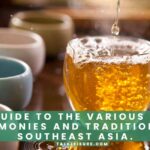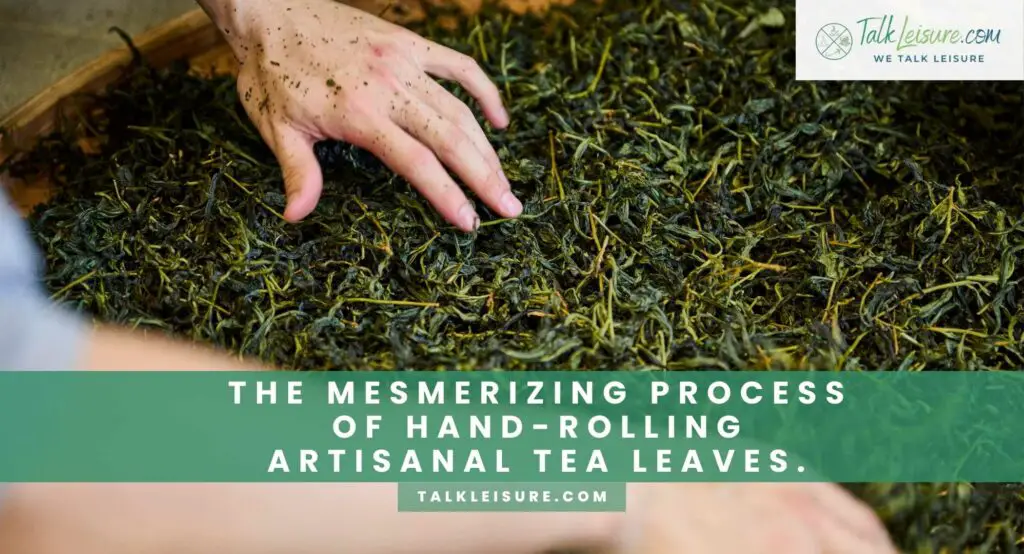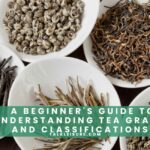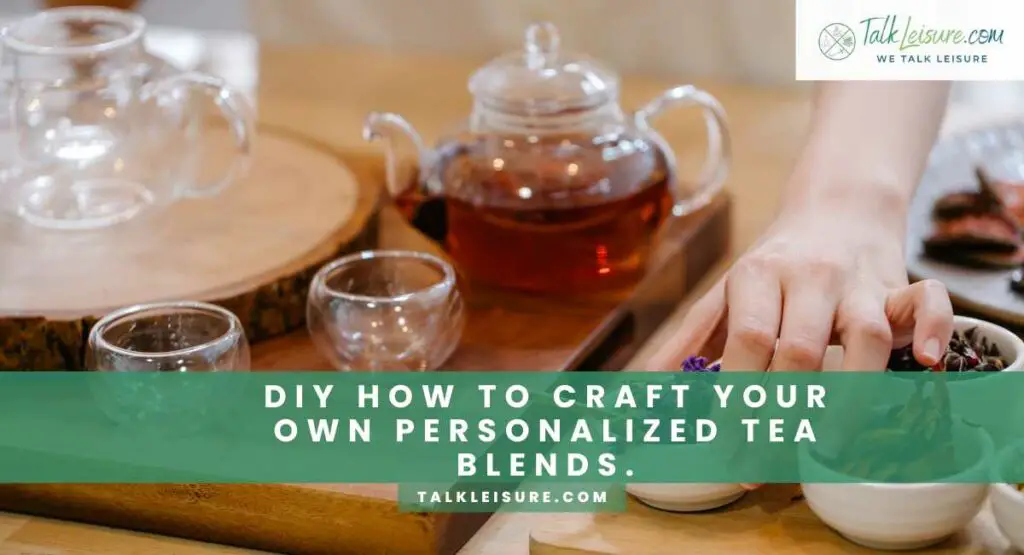Welcome to the enchanting world of tea tasting! If you’ve ever sipped a cup of tea and wondered about the intricate dance of flavors swirling in your mug, you’re in for a treat.
Tea tasting involves sipping and slurping to engage the palate, assessing dry and wet leaves for appearance and aroma, and developing a nuanced vocabulary to articulate flavors. It’s a sensory journey unlocking the diverse dimensions within each tea cup.
Tea tasting is not just a sensory experience; it’s a journey that takes you through the lush landscapes where tea leaves are nurtured, plucked, and transformed into the magical elixirs we adore.
Also read: The science behind the caffeine content in different teas.

Unlocking the Secrets in Every Sip
Tea tasting goes beyond the casual slurping of your morning brew. It’s an art form, a celebration of nature’s diversity encapsulated in every leaf. Imagine being able to discern the subtle notes of jasmine in a green tea or the robust earthiness of a well-aged pu-erh.
As we embark on this adventure, we’re not just tasting tea; we’re decoding the language of leaves.
Why Develop Your Palate?
Now, you might be thinking, “Why bother developing my palate? I already know what I like.” Fair point! But think of tea tasting as upgrading from a monochrome television to a high-definition screen. It’s about enhancing the richness of your experience, elevating your tea sessions from mundane to extraordinary.
Tea Tasting: More Than Just a Trend
In an era where trends come and go like the seasons, tea tasting stands timeless. It’s a practice that has withstood the test of centuries, a ritual embraced by cultures across the globe.
Whether you’re a seasoned connoisseur or a curious beginner, there’s always something new to discover in the world of tea.
What’s Ahead?
In this guide, we’ll embark on a journey that covers the A to Z of tea tasting. From understanding the basics of different tea varieties to refining your palate with advanced techniques, we’re here to demystify the art and science behind every sip.
So, grab your favorite teacup, settle into a cozy spot, and let’s dive into the fascinating universe of tea tasting together. Get ready to awaken your senses and cultivate a vocabulary that will transform your tea-drinking moments into a symphony of flavors!
Also read: The heartwarming stories of family tea traditions from around the world.
Understanding Tea Varieties
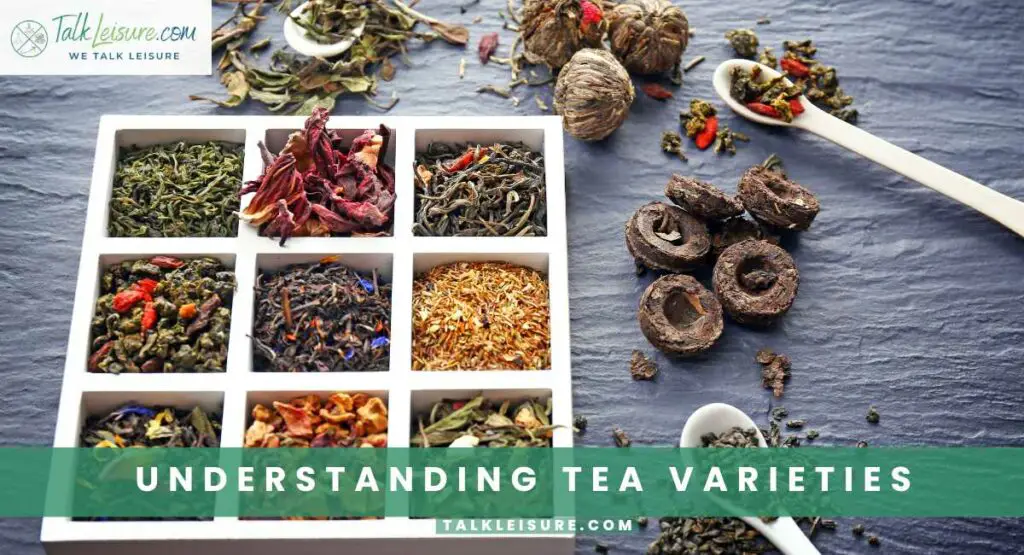
Different Types of Tea: Unveiling the Palette of Possibilities
Tea, like a diverse cast of characters, comes in a range of types, each with its own distinct personality. Let’s unravel the tapestry of flavors by exploring the main categories:
Green Tea:
Picture a fresh, grassy breeze captured in a cup. Green tea, with its vibrant color and delicate taste, undergoes minimal oxidation, preserving its natural antioxidants and providing a crisp, clean sip.
Black Tea:
Bold, robust, and steeped in history, black tea boasts a deep, reddish-brown hue. The leaves undergo full oxidation, resulting in a rich infusion with malty, sometimes fruity, notes. It’s the wake-up call your taste buds didn’t know they needed.
Oolong Tea:
Dancing between the realms of green and black tea, oolong is a captivating middle ground. Partial oxidation gives it a complex flavor profile, ranging from floral and fruity to woody and toasty. Each sip is an adventure, unfolding layers of taste.
White Tea:
The epitome of simplicity, white tea is the least processed among its counterparts. Delicate and subtly sweet, it captures the essence of young tea leaves and silvery buds. Consider it the serene poet in the world of tea.
Herbal Tea:
Breaking away from the traditional tea plant, herbal teas showcase a medley of botanicals. Chamomile, peppermint, hibiscus — the options are endless. Caffeine-free and bursting with diverse flavors, herbal teas offer a soothing escape from the ordinary.
The Impact of Terroir on Tea Flavor
Terroir, often associated with the finest wines, also plays a pivotal role in the world of tea. It’s the unique combination of soil, climate, altitude, and cultivation practices that imparts distinct characteristics to tea leaves:
Soil Composition:
Just as grapes express the essence of their soil, tea leaves absorb minerals that influence flavor. From the volcanic soils of Assam to the granite-rich slopes of Darjeeling, soil composition shapes the taste profile of tea.
Climate:
Sunshine, rainfall, and temperature variations contribute to the tea’s character. A misty mountainside may yield delicate, nuanced teas, while a sun-drenched valley might produce bolder, more robust flavors.
Altitude:
Tea plants, like intrepid explorers, thrive at different elevations. Higher altitudes often result in slower growth and concentrated flavors. Think of it as a tea plant’s way of adapting to its lofty surroundings.
Cultivation Practices:
From traditional hand-plucking to modern machinery, how tea is cultivated matters. The care with which leaves are harvested and processed influences the final infusion in your cup.
Understanding these facets of tea varieties and the impact of terroir is like decoding a secret language written in every leaf. As you delve into the nuances of each type, you’re not just sipping tea; you’re embarking on a journey through the landscapes where these leaves unfurl and come to life.
Setting Up Your Tea Tasting Space
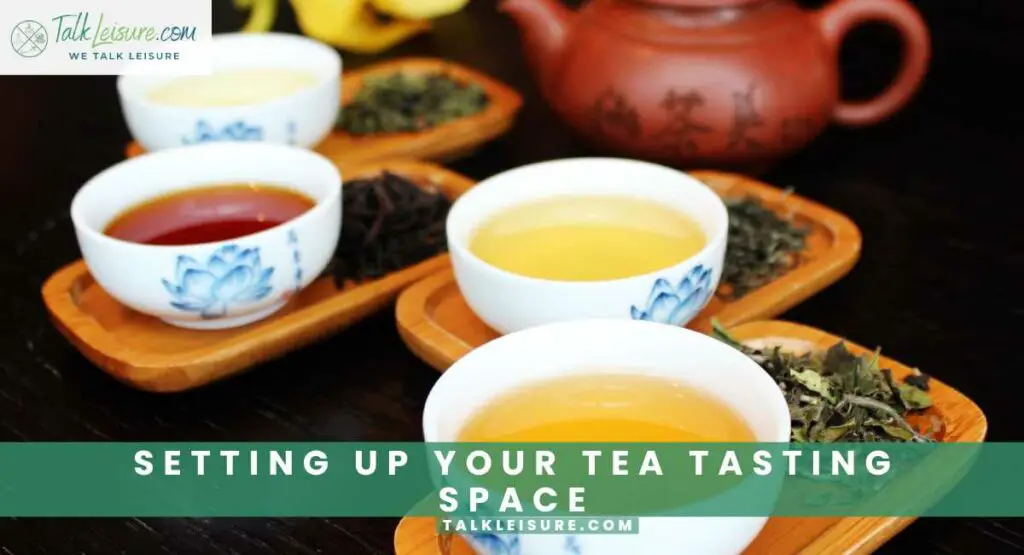
Choosing the Right Teaware: Elevate Your Sipping Experience
Before we dive into the art of tasting, let’s talk about the essential tools that will be your companions on this flavorful journey. The right teaware can turn a simple tea-drinking session into a ritualistic experience. Here’s your guide to selecting the perfect companions for your tasting adventure:
Teapots and Teacups:
Invest in a teapot that not only brews your tea efficiently but also allows the leaves to expand and infuse freely. Teacups should feel comfortable in your hands, enhancing the tactile pleasure of sipping.
For those diving into Chinese teas, a gaiwan is a must. This lidded bowl is perfect for gongfu-style brewing, allowing you to steep tea leaves multiple times and savor the evolving flavors.
Tea Infusers and Strainers:
Keep it simple with infusers or embrace the elegance of a strainer. These tools help separate leaves from your brew, ensuring a smooth, debris-free experience.
Tasting Sets:
For a curated experience, consider investing in a tea tasting set. These often include small cups, a pitcher, and other accessories designed specifically for savoring and evaluating tea.
Ideal Brewing Conditions: A Symphony of Temperature and Timing
Brewing tea is an art, and like any art form, it requires precision and a touch of intuition. Here’s how you can create the perfect stage for your tea to shine:
Water Temperature:
Different teas dance to different temperatures. Green teas prefer a cooler stage, around 160–185°F (71–85°C), while black teas might dazzle at a hotter 200–212°F (93–100°C). Invest in a temperature-controlled kettle or a reliable thermometer to hit the sweet spot.
Water Quality:
Tea is mostly water, so make it count. Use fresh, filtered water to avoid any unwanted flavors. The purity of your water will enhance the purity of your tea.
Brewing Time:
Timing is everything. Over-brewing can lead to bitter notes, while under-brewing might leave your tea shy of its full potential. Refer to the suggested steeping times for each type of tea and adjust according to your taste preferences.
Atmosphere:
Craft a serene space for your tea ritual. Whether it’s a cozy corner by the window or a dedicated tea nook, let the atmosphere complement the experience. Dim the lights, add some soft music, and let yourself be fully present in the moment.
As you assemble your teaware and set the stage for your tea tasting, remember that every element contributes to the symphony of flavors you’re about to encounter. It’s not just about drinking tea; it’s about creating an immersive experience that engages all your senses.
So, choose your teacups wisely, let the water dance at the right temperature, and get ready to embark on a sensory adventure in your own tea sanctuary.
Tea Tasting Basics: A Step-by-Step Guide
Welcome to the heart of tea tasting, where each step is a brushstroke in the canvas of flavor. As we embark on this aromatic journey, let’s break down the basics of tea tasting into a delightful sequence:
Observing the Dry Leaves: The Prelude to Flavor
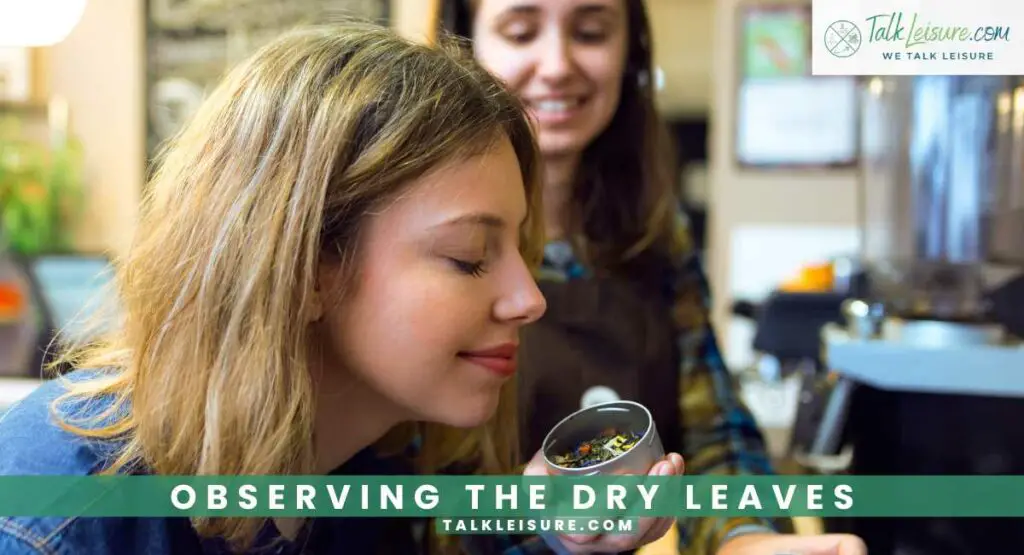
Before the dance of steeping begins, take a moment to appreciate the dry leaves. Much like a book’s cover hints at its contents, the appearance of tea leaves can reveal valuable insights:
Color and Shape:
Observe the color spectrum, from the deep emerald of a green tea to the ebony hues of a black tea. Note the shape and size of the leaves—rolled, twisted, or delicate buds—all of which contribute to the upcoming infusion’s character.
Texture:
Run your fingers through the dry leaves. Are they coarse or silky? The tactile experience can hint at the tea’s processing and freshness.
Inhale deeply. The dry leaves hold a prelude to the aromatic symphony you’re about to experience. Earthy, floral, grassy—let your senses roam through the fragrance.
Examining the Wet Leaves: Unfolding the Narrative
As hot water embraces the leaves, a transformation occurs. The leaves unfurl, releasing their essence into the infusion. This is where the tea story truly begins:
Expansion:
Witness the leaves expanding and unfurling. The degree of expansion can tell you about the tea’s freshness and how well it has been processed.
Color of the Liquor:
Take note of the liquor’s hue. Is it a pale gold, a rich amber, or something in between? The color can indicate the tea type and its oxidation level.
Consistency:
Examine the consistency of the wet leaves. Are they whole or broken? Whole leaves often signify a more delicate and nuanced flavor.
Noting Aroma Profiles: Inhale the Elixir
Now, bring your nose close to the brewed tea. The aroma is an integral part of the tasting experience, offering a preview of the flavors that will soon dance on your palate:
Top Notes:
Identify the top notes—the first scents that hit your senses. Is it a burst of floral freshness, a hint of sweetness, or a subtle earthiness?
Middle Notes:
Dig deeper into the aroma. What additional layers unfold as you continue to inhale? Middle notes reveal the complexity of the tea, showcasing a symphony of scents.
Base Notes:
The lingering aromas, the base notes, linger in the background. These can be the foundation of the tea’s flavor profile, providing depth and resonance.
As you progress through these steps, remember that tea tasting is a sensory exploration. Engage your eyes, nose, and fingers in the process. Each cup is a story waiting to be told, and you, the tea taster, are the storyteller.
So, with the aroma swirling around you, let’s move forward into the realm of taste, where the real adventure begins.
Tasting Techniques

Now that we’ve set the stage and observed the intricate details of our tea, it’s time to engage in the artful act of tasting. Prepare to awaken your taste buds and unlock the full spectrum of flavors with these two essential techniques:
The Sip and Slurp Technique: Dance of the Elixirs
Sipping tea is not a mere act; it’s a choreography of flavors on your palate. The sip and slurp technique is a time-honored tradition that allows you to fully experience the nuances of the brew:
Sipping:
Take a small, measured sip of the tea. Let it linger on your tongue for a moment, allowing the initial flavors to unfold. Pay attention to the texture—whether it’s silky, velvety, or brisk.
Slurping:
Here comes the fun part. Slurp the tea, drawing it into your mouth while incorporating air. This aerates the tea, spreading it across your palate and enhancing the sensory experience. Don’t be shy; the slurp is your ticket to capturing the full orchestra of flavors.
Engaging All Senses:
As you sip and slurp, engage your other senses. Close your eyes to focus on the taste. Feel the texture of the tea on your tongue. Let the aroma waft through your senses, creating a harmonious symphony of taste.
Aerating Your Tea for Maximum Flavor: Breathing Life into Every Drop
Aeration is the secret weapon in a tea taster’s arsenal. Just as a fine wine benefits from a bit of oxygen, so does your tea. Here’s how to elevate your sipping experience:
Pouring Height:
When transferring tea from pot to cup, vary the height of your pour. This introduces oxygen into the liquid, enhancing the tea’s aroma and flavor.
Swirling:
Give your cup a gentle swirl before sipping. This helps release additional aromas and flavors trapped in the liquid, ensuring every drop is a sensory delight.
Experimenting:
Feel free to experiment with the degree of aeration. Some teas, especially robust black teas, may benefit from more vigorous swirling, while delicate green teas may require a lighter touch.
As you master these techniques, you’ll find that tea tasting becomes more than a ritual—it becomes a dynamic and interactive experience. The sip and slurp, combined with thoughtful aeration, allow you to unravel the layers of complexity in each cup.
So, embrace these techniques, let the flavors dance on your palate, and savor the magic that unfolds with every sip. Cheers to the art of tea tasting!
Developing Your Tea Vocabulary
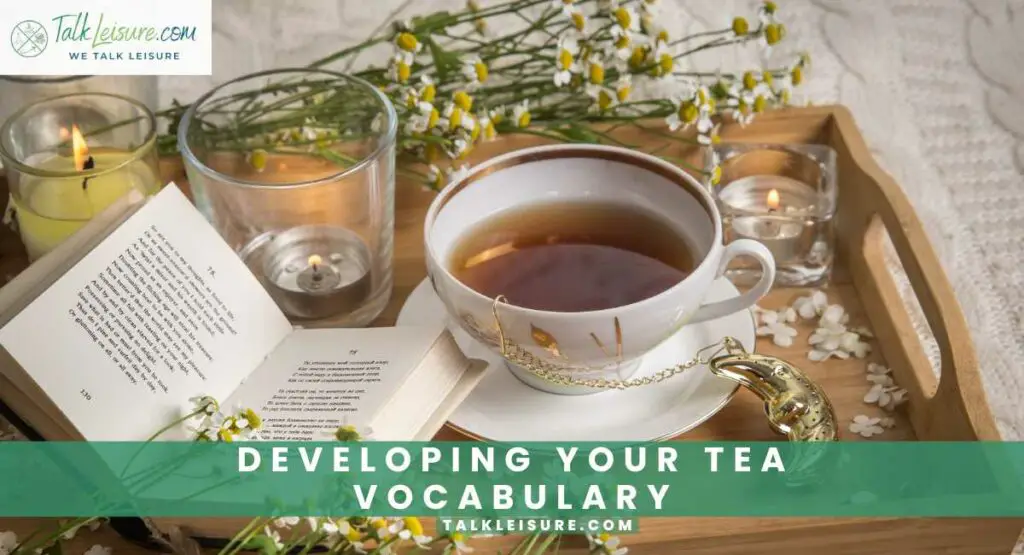
Tea tasting is a journey of discovery, and the language you use to describe your experience adds depth to the adventure. Let’s explore the art of articulating the intricate flavors and aromas found in your cup:
Common Flavor Descriptors in Tea Tasting: Decoding the Taste Palette
Tea, like a masterfully composed symphony, has a multitude of flavor notes waiting to be uncovered. Familiarize yourself with common descriptors to articulate the nuances:
Floral:
Teas often carry the delicate essence of flowers. Look out for notes reminiscent of jasmine, rose, or lavender, which can infuse your cup with a fragrant and uplifting quality.
Earthy:
Earthiness evokes the rich, grounding flavors found in certain teas. Think of the depth associated with soil, minerals, or even the woody tones reminiscent of a forest floor.
Fruity:
From the zing of citrus to the sweetness of berries, fruity notes add a vibrant and refreshing dimension to tea. Different teas may showcase a spectrum of fruity flavors, contributing to their complexity.
Nutty:
Teas with a nutty profile can bring warmth and richness to your palate. Almond, chestnut, or hazelnut undertones add a comforting layer to the overall taste.
Spicy:
Spices can lend teas a captivating kick. Whether it’s the warmth of cinnamon, the bite of ginger, or the complexity of cardamom, spicy notes can create a memorable tea experience.
Sweet:
Sweetness in tea is not always about adding sugar. Look for natural sweetness, be it honey-like, caramel, or molasses, which can balance out the brew and enhance its overall appeal.
Building a Personalized Tea Tasting Lexicon: Your Tea, Your Language
While common descriptors provide a shared vocabulary, developing your personal lexicon allows you to express the unique nuances that resonate with you. Here’s how to build your own tea tasting dictionary:
Keep a Tasting Journal:
Create a dedicated journal for your tea adventures. Record your observations, favorite flavor profiles, and any unique descriptors that come to mind. Over time, this becomes your personalized guide.
Experiment with Analogies:
Compare tea flavors to experiences, memories, or even colors. Does a particular oolong remind you of a sunset? Does a black tea evoke the coziness of a well-worn leather chair? Use these analogies to craft descriptions that resonate with you.
Share and Discuss:
Engage in conversations with fellow tea enthusiasts. Discussing flavors with others not only broadens your perspective but also helps refine your ability to express what you taste.
Trust Your Instincts:
Your taste buds are unique, and so is your perception of flavor. Trust your instincts, and don’t be afraid to create descriptors that capture the essence of your tea experience.
As you delve into the world of flavor descriptors and build your own tea tasting lexicon, remember that the beauty of tea lies in its subjective nature.
Whether you find poetry in a cup of oolong or revel in the robustness of black tea, your vocabulary is the key to unlocking the stories each brew has to tell. Embrace the language of tea, make it your own, and let your taste buds guide you through a world of endless possibilities.
Tea Tasting Scorecards and Note-Taking
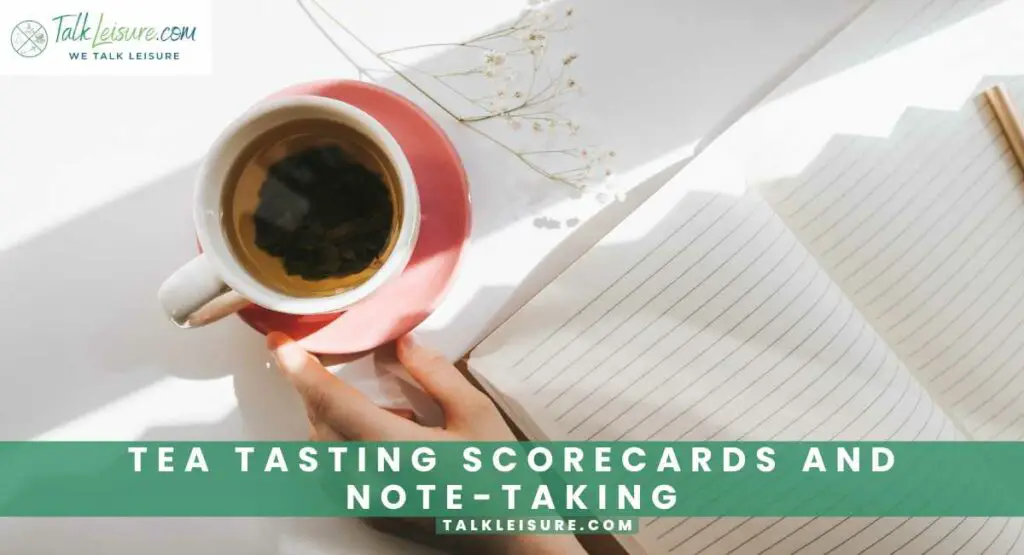
Tea tasting is not just a fleeting experience; it’s a journey that deserves to be documented and cherished. Let’s explore the tools and techniques that will help you capture the essence of each cup:
Creating a Tea Tasting Journal: Your Personal Tea Diary
A tea tasting journal is more than a notebook; it’s a time capsule of your sensory adventures. Here’s how to craft a journal that will become a treasured companion on your tea exploration:
Format and Sections:
Divide your journal into sections such as tea type, date, brewing details, and tasting notes. Having a structured format allows you to quickly reference and compare different sessions.
Visuals:
Include space for labels, tea packaging, or even doodles that reflect the mood of the session. Visual elements add a personal touch and make your journal visually engaging.
Tasting Notes:
Describe the dry leaves, the infusion process, and your sensory journey. Use the flavor descriptors you’ve learned and add any unique nuances you discover during the session.
Rating System:
Consider implementing a rating system to quantitatively capture your overall impression of the tea. This can be as simple as stars or a numerical scale. Over time, this helps you identify your preferences.
Reflections:
Leave space for reflections and observations. How did the tea make you feel? Did it evoke any memories or emotions? Your journal is a canvas for more than just flavor notes.
How to Score and Evaluate Teas: Unveiling the Grading Ritual
Scoring and evaluating teas adds a structured dimension to your tasting sessions. Here’s a guide on how to score and appreciate the nuances of each tea:
Appearance:
Evaluate the dry leaves and the infused leaves. Note the color, shape, and consistency. A visually appealing tea often sets the stage for a delightful tasting experience.
Aroma:
Assign a score to the fragrance of the dry leaves, the wet leaves, and the overall aroma of the brewed tea. A captivating aroma is a prelude to a satisfying cup.
Flavor Profile:
Break down the flavor into its components: sweetness, bitterness, astringency, and any specific notes you detect. Assign scores to each element to create a comprehensive profile.
Mouthfeel:
Consider the texture and body of the tea. Is it light and refreshing, or does it have a more substantial, full-bodied feel? The mouthfeel contributes significantly to the overall experience.
Aftertaste:
The lingering notes after swallowing, known as the finish or aftertaste, can reveal additional layers of the tea’s complexity. Note the duration and any evolving flavors.
Overall Impression:
Combine the individual scores to derive an overall impression. This holistic view encapsulates your entire experience with the tea, from the first whiff to the lingering aftertaste.
By incorporating these elements into your tea tasting journal, you transform each session into a systematic exploration. Your journal becomes a repository of knowledge, a guide that evolves with your palate, and a testament to the incredible diversity found in the world of tea. So, grab your pen, embrace the ritual of note-taking, and embark on a journey of tea discovery that goes beyond the cup.
Advanced Tea Tasting Techniques
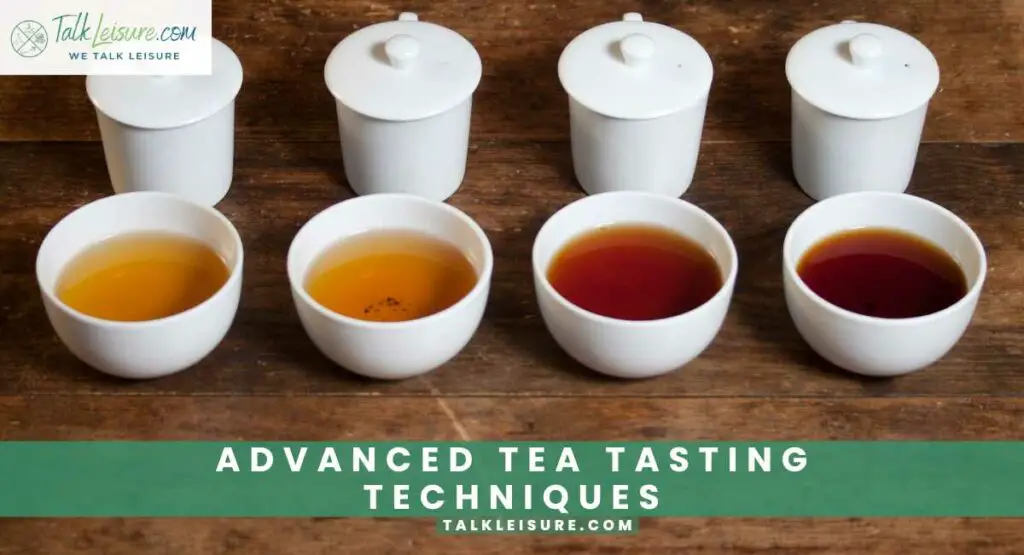
As you deepen your relationship with tea, it’s time to elevate your tasting skills to new heights. These advanced techniques go beyond the basics, inviting you to engage in more nuanced and challenging tea experiences:
Comparative Tasting: Exploring Similar Teas
Comparative tasting is a journey of discovery that involves sampling multiple teas side by side to discern subtle differences and appreciate unique nuances. Here’s how to embark on this advanced exploration:
Select Similar Teas:
Choose teas that share similarities, such as teas from the same region, the same type (green, oolong, black), or teas produced using similar processing methods. This allows you to focus on the finer distinctions.
Observe Differences:
Pay meticulous attention to the appearance, aroma, and flavor profiles of each tea. Take notes on the unique characteristics that distinguish one from the other. This practice hones your ability to discern subtleties.
Sequence Matters:
Consider the order in which you taste the teas. Start with the lighter, more delicate teas and gradually progress to the bolder ones. This helps prevent overpowering your palate and allows you to appreciate each tea’s distinct qualities.
Discuss and Compare:
Engage in discussions with fellow tea enthusiasts or, better yet, conduct blind tastings with friends. Sharing perspectives can broaden your understanding and reveal aspects you might have overlooked.
Refine Your Preferences:
Through comparative tasting, you not only refine your ability to distinguish flavors but also gain a clearer sense of your personal preferences. Understanding the intricacies of similar teas empowers you to choose teas that align with your taste.
Blind Tasting Challenges
Blind tasting adds an element of mystery to your tea exploration, challenging you to rely solely on your senses without preconceived notions. Here’s how to master the art of blind tasting:
Conceal Identities:
Have someone else prepare the teas for you without revealing their identities. This could involve placing teas in identical containers or using numbered samples. The goal is to eliminate any visual biases.
Engage Your Senses:
Focus on the sensory experience without knowing the tea’s origin, type, or processing. Smell the dry leaves, observe the infusion, and savor the flavors without preconceived expectations.
Analyze and Guess:
Take detailed notes on the appearance, aroma, taste, and mouthfeel of each tea. Afterward, try to identify the teas based on your observations. This exercise sharpens your sensory memory and analytical skills.
Embrace the Challenge:
Blind tasting can be humbling, as even seasoned tasters may find it challenging to accurately identify teas. Embrace the mystery, learn from the experience, and appreciate the surprises that each cup holds.
Gradual Complexity:
Start with simpler blind tastings and gradually increase the complexity. You can explore single-origin blind tastings, blends, or even teas with added elements like spices or flowers. The goal is to continually challenge and refine your palate.
These advanced tea tasting techniques push the boundaries of your sensory perception, encouraging a deeper understanding of tea varieties and enhancing your ability to articulate the intricate world of flavors.
So, gather your teas, set the stage for exploration, and immerse yourself in the advanced art of tea tasting.
Conclusion: Continuing Your Tea Tasting Journey
Embark on a lifelong journey of tea exploration, where each sip unveils a new chapter in the vast world of flavors. Embrace the art of tea tasting with curiosity and an adventurous spirit.
Encourage yourself to explore diverse teas, experiment with brewing methods, and cultivate a palate attuned to the nuances of each cup. To deepen your knowledge, tap into a wealth of resources: books, online courses, and tea communities.
The world of tea is boundless; keep steeping, sipping, and discovering. May your teacup be a vessel for endless discovery and joy. Happy tea tasting!
Frequently Asked Questions
- What are the skills of tea tasting?
Tea tasting requires keen sensory perception to identify flavors, aromas, and textures. Developing a discerning palate involves recognizing nuances like sweetness, bitterness, and astringency. Mastery of brewing techniques, from water temperature to steeping times, is crucial. Additionally, the ability to articulate and document tasting experiences enhances one’s journey into the intricate and diverse world of tea.
- What does a professional tea taster do?
A professional tea taster, often employed by tea companies or plantations, evaluates tea quality for production and blends. Their responsibilities include assessing aroma, flavor, and appearance, ensuring consistency and adherence to quality standards.
They may engage in sample cupping, analyze tea characteristics, and contribute to creating unique blends. Professional tea tasters also stay updated on industry trends, conduct quality control, and play a pivotal role in maintaining the overall excellence of tea products. Their refined palate and expertise are essential for producing high-quality teas that meet consumer expectations.
- What makes tea expire?
Tea can lose freshness and flavor over time due to exposure to air, moisture, light, and extreme temperatures. These factors contribute to oxidation, loss of aroma, and potential growth of mold. Proper storage in an airtight container, away from light and moisture, helps preserve tea quality. While it doesn’t truly expire, tea is best enjoyed within recommended time frames for optimal taste.

